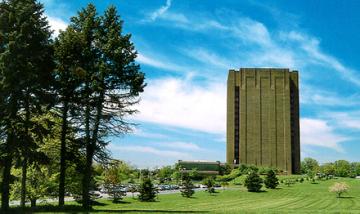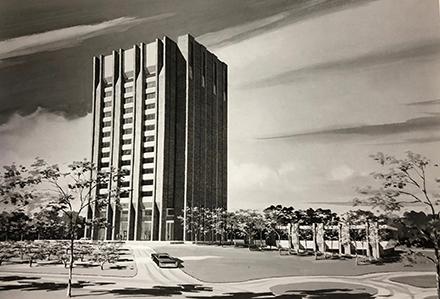National Agricultural Library Celebrates 50 Years in Beltsville, MD

The 15-story National Agricultural Library sits in the heart of the Agricultural Research Service's 6,600 acres of property in Prince Georges County, Maryland.
The National Agricultural Library (NAL) celebrated 50 years in Beltsville, MD, in November 2019.
The 15-story building—the tallest in the area—is highly recognizable in the landscape, and can be seen from the Baltimore-Washington Parkway and the Washington Beltway. It sits on Route 1, at the heart of the Beltsville Agricultural Research Center (BARC), which occupies 6,600 acres in Maryland’s Prince Georges County. Both NAL and BARC are part of the Agricultural Research Service, USDA’s in-house research agency.
Groundbreaking took place early in 1967, and the cornerstone was laid by Agriculture Secretary Orville Freeman on September 21. Construction took more than 2 years.
Though the building was not finished, librarians moved in in May 1969. They answered patron questions and filled research requests while construction workers kicked up dust around them. Doors opened to the public on August 1. The building was officially complete in November 1969.
The National Agricultural Library—and the Department of Agriculture—were established by President Abraham Lincoln on May 15, 1862. His signature on the Organic Act established the library’s basic mission: that the commissioner of Agriculture “acquire and preserve in his Department, all information concerning agriculture which he can obtain by means of books and correspondence ….”

Architectural drawing of the National Agricultural Library.
The library, which collects USDA documents, scientific papers, maps, and other agriculture-related books and pamphlets, was originally housed in the Department of Agriculture offices in Washington, DC, with a few outlying “branches,” such as the Agricultural Division of the Patent Office. Branch collections were eventually gathered into the main library.
As the amount of materials grew, the library was moved from location to location, ending up by 1892 “in a large high-ceilinged room with galleries in the central portion of the second floor of the main Department Building,” according to Alan E. Fusoni, historian and former head of NAL’s Special Collections Unit. Even then, the space was not large enough for its collections. In 1908, the library was moved to the basement of the East Wing of the Department building. Space continued to be a problem.
In March 1915, it was moved to the new Bieber Office Building on B St., SW, in Washington, and in the summer of 1932, the library moved again to the main USDA building on Independence Ave. Even though it occupied the first floor of two wings, storage remained an issue.
In 1940, a subcommittee was formed from the Agriculture Committee to look into the space issues. Nothing came of it. By 1959, the problem could no longer be ignored. However, instead of focusing on land acquisition or moving the library to a new building, the committee suggested weeding the inventory and binding materials—which would provide better access and help with preservation.
Around 1962, NAL director Foster Mohrhardt asked the subcommittee to appropriate funds for a study to determine what could be done to preserve the collection and to increase space, either through expansion or a new building. After visiting the library, a subcommittee member is quoted as saying that it lacked proper lighting and ventilation and “wasn’t fit to store corn.” Periodicals were stacked on the floor due to lack of shelf space, and rare books stored in another building were deteriorating quickly due to a lack of climate control and leaky pipes.
Funds were finally appropriated in 1963 to hire an architect.
A 1963 Senate report states, “Consider the National Agricultural Library’s condition. It outgrew its present, antiquated quarters 20 years ago. Building plans were considered as far back as 1940. Yet, it remains seriously deficient in space and equipment.”
Due to costs, USDA had to look outside of Washington to build. The Department had purchased a large amount of land from the University of Maryland in 1938. The acreage was about 15 miles outside of Washington and not subject to the same property rates. Since USDA already owned it, the property was essentially free to use, and so it was chosen for construction.
The new building designs included plans for 20 years of expansion, with shelving space necessary to hold up to 2 million books and periodicals. Director Mohrhardt hoped the building would last beyond 20 years because he knew of the technological advances being made; the library was already a pioneer in the use of microfilm and microfiche.
Currently, the library’s holdings include over 16 million volumes.—By Kelly A. Harmon, National Agricultural Library.
Facts about the National Agricultural Library building:
-
The contract to build was awarded in November 10, 1966. Completion was estimated for October 1968.
-
Cost: $7,450,000
-
The 15-story tower is made of precast concrete and rock-faced brick.
-
Including the wings, the building provides 275,000 square feet of space.
-
Space on the 4th through 13th floors was intended to hold 2 million books; the library currently houses over 16 million books.
Read more in Facts About the Building, prepared November 1967.
You May Also Like

